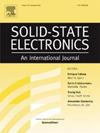硅mosfet中具有成本效益的源极/漏极形成的自旋掺杂技术
IF 1.4
4区 物理与天体物理
Q3 ENGINEERING, ELECTRICAL & ELECTRONIC
引用次数: 0
摘要
自旋掺杂(SOD)技术是形成mosfet源极和漏极的一种经济有效的方法。荒漠硅P-280是一种磷基掺杂剂,浓度为1.9 × 1022 cm−3。在3000转/分钟下旋转涂层30秒后,退火在800至900°C的温度范围内进行。随着退火温度的升高,片材电阻从1260显著降低到161 Ω/sq。相比之下,在电阻率为~ 1 Ω·cm的掺硼硅衬底上,结深从0.14µm增加到0.32µm。为了评估采用超氧化物歧化酶工艺制备的mosfet的电性能,使用Silvaco技术计算机辅助设计软件进行了器件模拟,并与传统离子注入制备的mosfet的实验结果进行了比较。结果表明,基于sod的MOSFET表现出阈值电压(Vth)为~−0.30 V,亚阈值摆幅(SS)为~ 86 mV/dec,跨导(gm)为~ 0.89 mA/V,以及相当的导态电流。相比之下,传统离子注入mosfet的Vth为−0.25 V, SS为197.1 mV/dec, gm为0.916 mA/V。这些结果表明,SOD技术是MOSFET制造中掺杂激活和结形成的一种有前途的替代方法,提供了工艺简单和成本效率,尽管在亚阈值性能方面存在一些折衷。本文章由计算机程序翻译,如有差异,请以英文原文为准。
Spin-on dopant technology for cost-effective source/drain formation in silicon MOSFETs
Spin-on dopant (SOD) technology is utilized as a cost-effective approach for forming the source and drain regions of MOSFETs. Desert Silicon P-280, a phosphorus-based dopant with a concentration of 1.9 × 1022 cm−3, is used in doping. Following spin-coating at 3000 rpm for 30 s, annealing is performed at temperatures ranging from 800 to 900 °C. As the annealing temperature increases, the sheet resistance significantly decreases from 1260 to 161 Ω/sq. In contrast, the junction depth increases from 0.14 to 0.32 µm on a boron-doped silicon substrate with a resistivity of ∼1 Ω·cm. To assess the electrical performance of the MOSFETs formed using the SOD process, device simulations are performed out using Silvaco technology computer-aided design software and compared with experimental results from MOSFETs fabricated via conventional ion implantation. The results reveal that the SOD-based MOSFET exhibits a threshold voltage (Vth) of ∼−0.30 V, a subthreshold swing (SS) of ∼86 mV/dec, the transconductance (gm) of ∼0.89 mA/V, along with a comparable on-state currrent. In comparison, conventional ion-implanted MOSFETs show a Vth of −0.25 V, SS of 197.1 mV/dec, and gm of 0.916 mA/V. These results demonstrate that the SOD technique is a promising alternative for dopant activation and junction formation in MOSFET fabrication, offering process simplicity and cost efficiency, albeit with some trade-offs in subthreshold performance.
求助全文
通过发布文献求助,成功后即可免费获取论文全文。
去求助
来源期刊

Solid-state Electronics
物理-工程:电子与电气
CiteScore
3.00
自引率
5.90%
发文量
212
审稿时长
3 months
期刊介绍:
It is the aim of this journal to bring together in one publication outstanding papers reporting new and original work in the following areas: (1) applications of solid-state physics and technology to electronics and optoelectronics, including theory and device design; (2) optical, electrical, morphological characterization techniques and parameter extraction of devices; (3) fabrication of semiconductor devices, and also device-related materials growth, measurement and evaluation; (4) the physics and modeling of submicron and nanoscale microelectronic and optoelectronic devices, including processing, measurement, and performance evaluation; (5) applications of numerical methods to the modeling and simulation of solid-state devices and processes; and (6) nanoscale electronic and optoelectronic devices, photovoltaics, sensors, and MEMS based on semiconductor and alternative electronic materials; (7) synthesis and electrooptical properties of materials for novel devices.
 求助内容:
求助内容: 应助结果提醒方式:
应助结果提醒方式:


